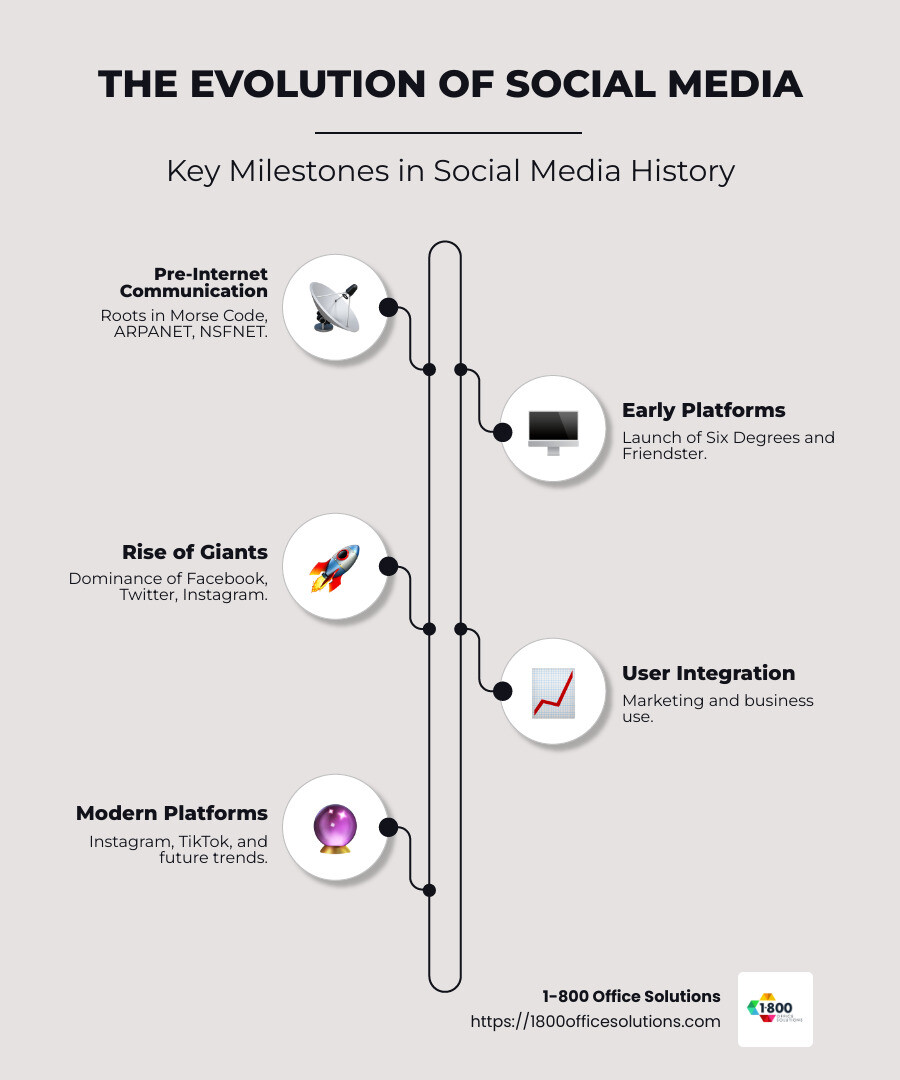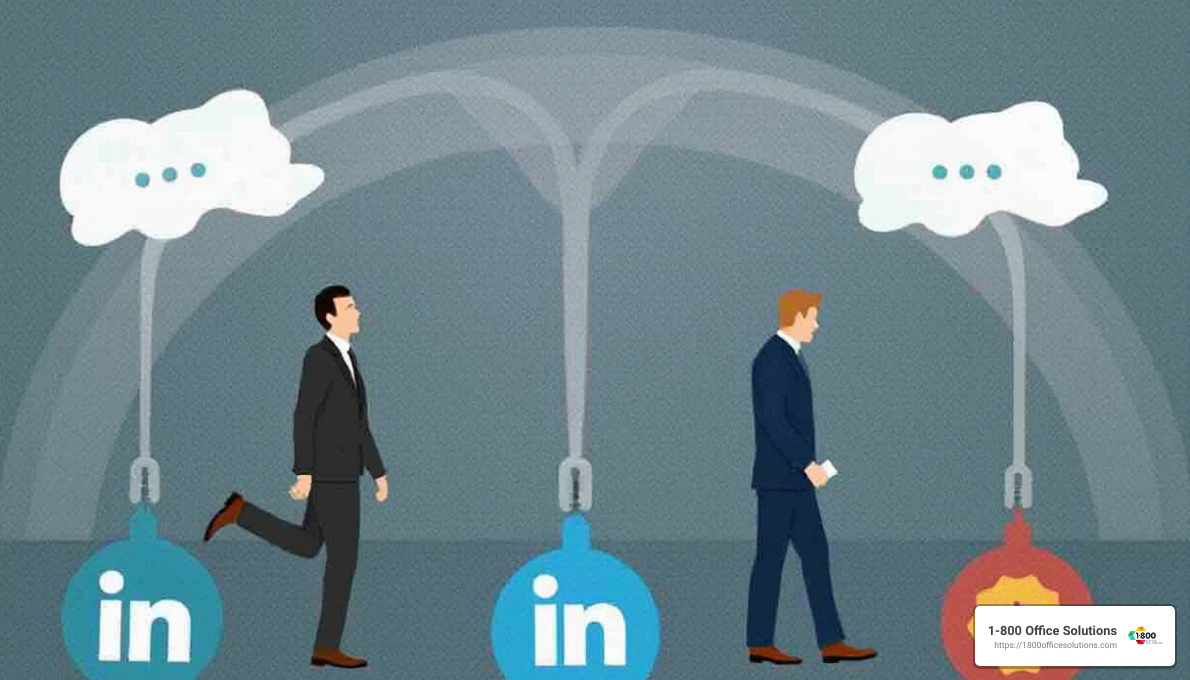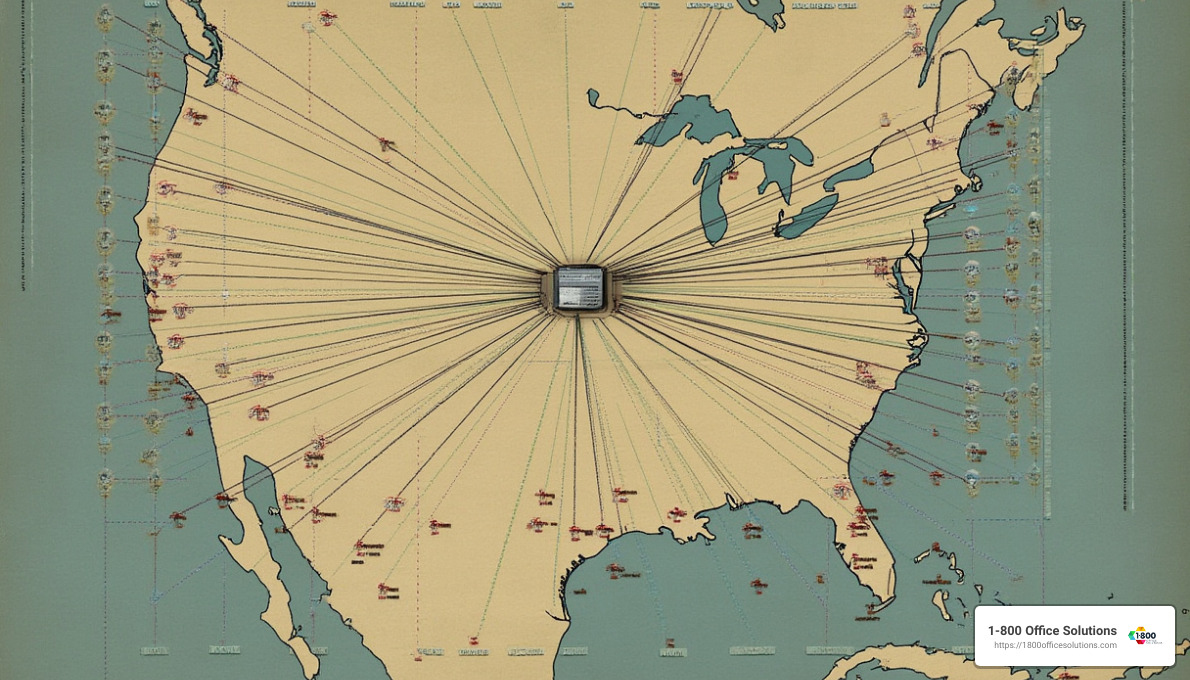An Essential Guide to the History and Evolution of Social Media
The history and evolution of social media explained begins with the simple human desire to connect and communicate, paired with the rapid advancements in digital technology. Social media platforms have fundamentally transformed how we interact with one another, share information, and engage with media. At its core, social media is defined as digital technologies that enable the sharing of ideas and information through virtual networks.
Key Points:
- Origin: Social media started with early platforms like Six Degrees and Friendster in the late 1990s, paving the way for giants like Facebook, Twitter, and Instagram.
- Purpose: Originally for personal interaction, social media now serves as a vital tool for marketing, communication, and global commerce.
- Growth: From just 5% of American adults in 2005 to 72% in 2019, social media usage showcases exponential growth.

The history and evolution of social media explained glossary:
- Google algorithms explained: Everything you need to know
- SearchGPT explained: Details about OpenAI’s search engine
- Pros and cons of facial recognition
The Pre-Internet Roots of Social Media
Before we dive into Facebook and Twitter, let’s rewind to the origins of digital communication. The roots of social media trace back much further than you might think.
Morse Code: The First Electronic Communication
In 1844, Samuel Morse sent the first telegraph message from Washington, D.C., to Baltimore. This was a groundbreaking moment in human communication, as it allowed messages to be sent over long distances almost instantly. Morse code was the first time people could communicate electronically, setting the stage for future innovations.

ARPANET: The Birth of the Internet
Fast forward to 1969, when the Advanced Research Projects Agency Network (ARPANET) was created by the U.S. Department of Defense. ARPANET was the first network to implement the TCP/IP protocol suite, which is the foundation of today’s internet. It allowed computers at different universities to share information, marking the beginning of networked communication.

NSFNET: Expanding the Network
In 1987, the National Science Foundation launched NSFNET, a more robust digital network that connected supercomputing centers across the United States. NSFNET increased the speed and capacity of the network, making it more accessible to a broader audience. This development laid the groundwork for the modern internet and, subsequently, social media.
These early innovations in digital communication paved the way for the social media platforms we know today. By connecting people and information across vast distances, they set the stage for the rapid growth of online communities and the digital world we now live in.
The Launch of Social Media Platforms
The history and evolution of social media explained through a few key platforms that revolutionized how we connect online. Let’s explore the pioneers that laid the groundwork for today’s digital social landscape.
Six Degrees: The First Social Network
In 1997, Six Degrees emerged as the first recognizable social media platform. Named after the “six degrees of separation” theory, it allowed users to create profiles, list their friends, and browse these connections. With a peak of around 3.5 million users, Six Degrees showcased the potential of digital networking. Although it closed in 2001, it paved the way for future platforms.
Friendster: A Leap Forward
Launched in 2002, Friendster quickly gained popularity by allowing users to connect with friends, share photos, and leave comments. Within months, it had over 3 million users, a testament to its appeal. Friendster’s user-friendly features made it a stepping stone for future social networks, reaching over 100 million users at its height. Despite its eventual decline and closure in 2019, it left a lasting impact on online social interaction.
MySpace: The Social Giant
MySpace
, launched in 2003, became a cultural phenomenon. It allowed users to customize profiles, share music, and connect with a global audience. By 2006, MySpace was the most visited website, surpassing even Google. However, its heavy use of advertisements and the rise of Facebook led to its decline. Despite this, MySpace remains a significant chapter in social media history, illustrating both the possibilities and pitfalls of online networking.
LinkedIn: Professional Networking
also launched in 2003 but took a different approach by focusing on professional networking. It allowed users to connect with colleagues, seek job opportunities, and showcase their professional achievements. LinkedIn’s unique focus on business networking helped it grow to over 575 million users. Today, it remains a vital tool for professionals worldwide, demonstrating the diverse applications of social media.
These platforms were the building blocks of modern social media, each contributing unique features and lessons. They set the stage for the giants like Facebook and Instagram that would soon follow, forever changing how we communicate and connect online.
The History and Evolution of Social Media Explained
The history and evolution of social media explained through key platforms like Facebook, Twitter, Instagram, and TikTok highlight the dynamic nature of online interaction and connectivity.
Facebook: The Social Media Titan
was launched in 2004 by Mark Zuckerberg and quickly became a household name. Originally designed for college students, it expanded to the general public in 2006. By 2019, Facebook had grown to over 2.4 billion users worldwide. Its ability to connect people through friend requests, wall posts, and photo sharing made it a social media powerhouse. Facebook’s introduction of the “like” button and news feed revolutionized how people interacted online and set a standard for social engagement.
Twitter: The Microblogging Pioneer
entered the scene in 2006, offering a unique platform for real-time updates and microblogging. Users could post “tweets” limited to 280 characters, allowing for quick and concise communication. Twitter became a go-to source for news, trends, and public discourse. Its use of hashtags created a new way to organize and find content. By 2023, Twitter, now rebranded as X, continued to be a vital platform for breaking news and global conversations.
Instagram: The Visual Storyteller
Launched in 2010, Instagram focused on visual content, allowing users to share photos and short videos. Its intuitive design and use of filters attracted millions, especially among younger demographics. Acquired by Facebook in 2012, Instagram introduced features like Stories and Reels, encouraging creativity and engagement. With over 1 billion users by 2023, Instagram remains a favorite platform for influencers and brands, emphasizing the power of visual storytelling in social media.
TikTok: The Short-Form Video Sensation
TikTok
, launched by ByteDance in 2016, took the world by storm with its short-form video content. It merged with the U.S.-based app Musical.ly in 2018, expanding its reach. TikTok’s algorithmically curated feed and easy-to-use editing tools made it a hit with teens and young adults. By 2020, TikTok had over 800 million users globally, becoming a cultural phenomenon and inspiring new trends and challenges. Its rapid growth underscores the evolving preferences for interactive and engaging content.
These platforms illustrate the rapid evolution of social media, each bringing unique innovations that have reshaped how we connect and communicate. They highlight the diverse ways social media can influence culture, business, and everyday life.
Next, we will explore the impact of social media on both society and business, examining how these platforms have transformed marketing strategies and user interactions.
The Impact of Social Media on Society and Business
Social media has transformed how businesses and society interact. Let’s explore how user data, marketing, and influencer marketing play a role in this change.
User Data: The New Goldmine
Social media platforms like Facebook and Instagram gather vast amounts of user data. This data includes what users like, share, and comment on. Companies use this information to understand consumer behavior and preferences better. According to a recent article on IAS Insider, platforms paint vivid pictures of users, making targeted marketing more effective.
Key Points:
- Platforms track user demographics and interests.
- Data helps businesses tailor their products and services.
- It enables more personalized marketing strategies.
Marketing: A New Frontier
The rise of social media has given birth to social media marketing. Businesses place ads on platforms like Facebook and TikTok to reach millions of potential customers. But it’s not just about paid ads. Companies also focus on organic content to engage users without spending directly on ads.
Benefits of Social Media Marketing:
- Increases brand awareness.
- Generates leads and conversions.
- Fosters customer relationships.
- Offers insights into competitors’ strategies.
Social media marketing combines paid advertising and organic outreach, evolving into a vital digital marketing specialty.
Influencer Marketing: The Power of Trust
Influencer marketing
leverages individuals with large followings to promote products. These influencers, often viewed as trustworthy by their followers, can sway purchasing decisions significantly. Engaging influencers allows brands to tap into existing audiences efficiently.
Influencer Marketing Highlights:
- Builds trust and authenticity.
- Expands brand reach quickly.
- Drives engagement through relatable content.
Influencers bridge the gap between brands and consumers, offering a personal touch that traditional marketing methods often lack.
Social media has revolutionized how businesses interact with their audience. By using user data, embracing innovative marketing strategies, and leveraging the power of influencers, companies can thrive in the digital age. Next, we’ll tackle frequently asked questions about social media, providing further insights into its evolution and impact.
Frequently Asked Questions about Social Media
Social media
is defined by Merriam-Webster as electronic communication platforms that enable users to create online communities for sharing information, ideas, and other content. These platforms have evolved from simple communication tools to complex networks that connect billions of people worldwide.
Originally, social media started as a way to interact with friends and family. Over time, it expanded to serve various purposes—ranging from entertainment to business marketing. Modern social media platforms like Facebook, Twitter, and Instagram have transformed into powerful tools for personal expression, business promotion, and global communication.
Social media has undergone significant changes since its inception. Early platforms, like MySpace, were primarily about connecting with friends and sharing personal updates. As technology advanced, so did the capabilities of these platforms. They became more interactive and visually engaging, allowing for the sharing of videos, live streams, and more.
Digital connection has become more seamless, with platforms integrating features like instant messaging and video calls. This evolution has also led to a rise in commercial business activities on social media, where companies engage with customers, advertise products, and gather insights through user interactions.
The early 2000s marked the beginning of social media’s popularity. MySpace was one of the first platforms to gain widespread attention, reaching a million monthly active users around 2004. It was a pivotal moment, as it signaled the start of a new era in digital communication and networking.
From there, platforms like Facebook and Twitter emerged, rapidly growing their user bases and expanding the reach and influence of social media. These platforms have become integral to daily life for billions, shaping how we communicate, consume information, and connect with others.
Let’s dig deeper into the future of social media and how companies like 1-800 Office Solutions can steer this ever-changing landscape.
Conclusion
As we look to the future, social media is ready for even more change. With advancements in technology and changing user expectations, platforms will need to adapt to remain relevant. Trends suggest a shift towards more personalized content, improved privacy measures, and a focus on community building. Video content will continue to dominate, offering immersive experiences that engage users like never before.
At 1-800 Office Solutions, we understand the importance of staying ahead in this digital age. As social media evolves, so do the opportunities for businesses to connect with their audience. We are committed to helping you steer this dynamic landscape with our expert office solutions. Whether it’s enhancing your digital marketing strategy or leveraging the latest communication tools, we’re here to support your business growth.
Explore our range of services to find the best solutions custom to your needs. Find more about our office solutions here.
The future of social media is bright and full of possibilities. By staying informed and adaptable, businesses can harness its potential to foster meaningful connections and drive success.











